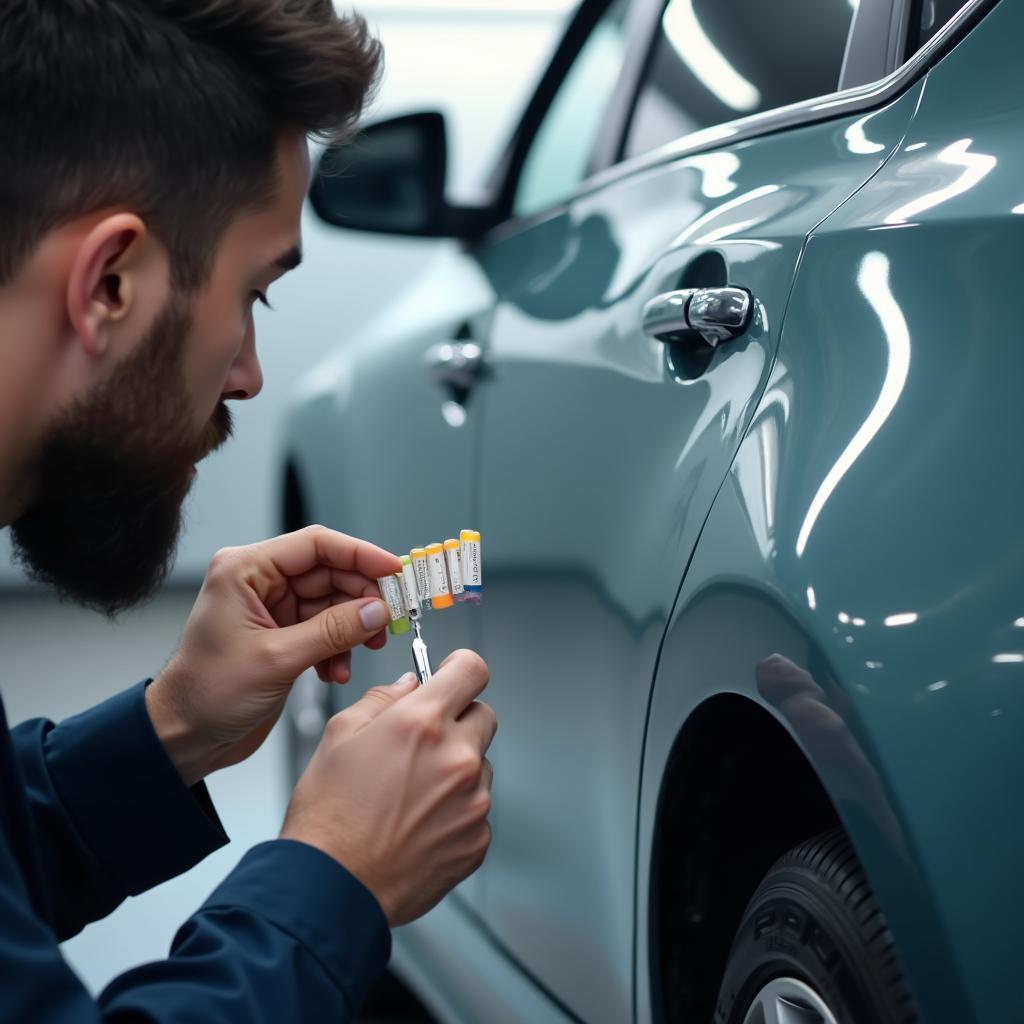Getting into an accident is never fun, and often leaves your car worse for wear. Thankfully, a skilled body shop can make your car look good as new, but getting the paint just right is a critical piece of the puzzle. Let’s dive into what you need to know about your car paint after body repair to ensure a seamless and satisfying finish.
Understanding the Paint Process After Body Repair
A proper car paint job after body repair is much more involved than a simple spray and go. Here’s a simplified breakdown of the steps involved:
- Preparation is Key: Before any paint touches your car, the body shop will meticulously prepare the surface. This involves sanding down any imperfections, smoothing out the area to be painted, and ensuring a clean surface free of dust and debris.
- Primer Application: Primer acts as a foundation for the paint. It helps the paint adhere better and provides a uniform surface for a smooth, even finish.
- Color Matching: Getting the paint color right is crucial. Autobody technicians use sophisticated color-matching systems to precisely blend the paint to match your car’s original finish, taking into account factors like fading and paint codes.
- Applying the Paint: The actual painting process typically involves multiple layers, starting with a base coat that provides the color. A clear coat is then applied on top for protection, shine, and that “just-like-new” look.
- Drying and Curing: After the paint is applied, it needs adequate time to dry and cure. This ensures the paint hardens properly, creating a durable and long-lasting finish that can withstand the elements.
Common Issues with Car Paint After Body Repair
While skilled technicians strive for perfection, some common issues can arise with car paint after body repair. Being aware of these can help you identify and address them early on:
- Paint Mismatch: Even with advanced technology, slight color discrepancies can occur. This is often due to the original paint fading over time, making a perfect match challenging.
- Orange Peel: This refers to a textured surface that resembles the peel of an orange. It occurs when the paint doesn’t flow out smoothly, often due to incorrect spraying techniques or environmental factors.
- Fish Eyes: These are small craters or dimples in the paint’s surface, resembling a fish’s eye. They typically happen when contaminants like oil or grease are present on the surface before painting.
- Peeling or Bubbling: If you notice paint peeling or bubbling, it suggests a problem with the paint’s adhesion. This could be due to improper surface preparation, moisture trapped underneath, or low-quality paint.
- Overspray: This is when paint accidentally lands on unintended areas, such as trim, moldings, or windows. It’s a sign of carelessness and should be addressed by the body shop.
Ensuring Quality Car Paint After Body Repair
You can take steps to help ensure a high-quality paint job:
- Choose a Reputable Body Shop: Do your research and select a body shop with a solid reputation for quality work and excellent customer service. Ask for recommendations from friends or family and read online reviews.
- Communicate Your Expectations: Clearly communicate your expectations to the body shop. Ask about their paint process, color-matching techniques, and the quality of materials they use.
- Thorough Inspection: Before driving your car home, thoroughly inspect the paint job in good lighting. Look for any inconsistencies in color, texture, or finish. Don’t hesitate to point out any concerns to the body shop.
Caring for Your Car Paint After Repair
Once you have a fresh coat of paint on your car, it’s important to care for it properly to maintain its shine and longevity:
- Gentle Washing: When washing your car, use a mild car wash soap and a soft sponge or microfiber mitt. Avoid harsh detergents or abrasive materials that can scratch the paint.
- Regular Waxing: Applying a high-quality car wax every few months will protect the paint from UV rays, environmental contaminants, and minor scratches.
- Addressing Issues Promptly: If you notice any paint chips, scratches, or other issues, get them addressed by a professional as soon as possible to prevent further damage.
FAQs about Car Paint After Body Repair
Q: How long does it take for car paint to cure after a repair?
A: While the paint may feel dry to the touch within a day or two, complete curing can take several weeks. During this time, it’s essential to follow the body shop’s recommendations for washing, waxing, and protecting the paint.
Q: Can I wax my car immediately after a paint repair?
A: It’s best to wait at least 30-60 days before waxing freshly painted surfaces. Waxing too soon can interfere with the curing process and lead to imperfections in the finish.
Q: Is it normal for car paint to fade over time?
A: Yes, some degree of paint fading is inevitable, especially with exposure to sunlight, UV rays, and environmental pollutants. Regular washing, waxing, and parking your car in a garage can help minimize fading.
Q: How can I remove minor scratches from my car’s new paint?
A: For minor scratches, you can use a scratch remover product specifically designed for car paint. For deeper scratches, it’s best to consult a professional to avoid causing further damage.
Need help with car paint repair?
Finding a trustworthy auto body shop can be challenging. For help finding reputable car paint repair shops in your area, CarRepairOnline has resources and information. We are committed to providing you with the guidance you need for all your car repair needs.
Don’t hesitate to reach out for assistance if you’re facing issues with car paint repair sun damage or any other paint-related problems. Our team at CarRepairOnline is here to connect you with the right professionals. Contact us today for expert advice and reliable solutions.



